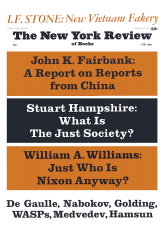In response to:
Keeping Up with the News from the December 16, 1971 issue
To the Editors:
Roger Sale’s review of Three Trapped Tigers [NYR, December 16] begins with some words about Guillermo Cabrera Infante’s alienation from the revolutionary Cuban government and his subsequent exile. Sale goes on to say that this situation “is irrelevant to the novel, which is only marginally political.” I must disagree, for it is my belief that Cabrera Infante’s political situation has been quite relevant to the novel, which is deliberately apolitical.
Your readers might be interested in knowing that the version of Three Trapped Tigers that won literary prizes in Spain was a political novel called Vista del amanecer en el tropico; that earlier Cabrera Infante had published a collection of short stories, Asi en la paz como en la guerra, which reflected his revolutionary militancy during the period in which Three Trapped Tigers takes place; and that the author changed his earlier novel into Tres Tristes Tigres (Three Trapped Tigers) when he became convinced of the incompatibility of literature and politics.
Though it may be argued that the final version is the novel under review and that the genesis of a novel is not essential to an understanding of the finished product, I know Cabrera Infante’s readers must wonder why the author makes only passing allusions to the fact that this is the bloodiest, most brutal period in Cuban history. The novelist has quite deliberately chosen to ignore political history and its horrors. In a later autobiographical short story, “Delito por bailar el chachachá,” which is strongly critical of the postrevolutionary literary establishment, he takes a position which I can only call that of the militant uncommitted writer. Though not totally in agreement with that position, I must admire its courage, especially since it alienates him from his fellow Latin American writers, who until the recent Padilla affair had nothing but praise for the Cuban government.
Finally, I was amazed at Roger Sale when he wrote:
For the most part the book is monologues given by what at first seems many but then devolves to two speakers, one a photographer named Arsenio Cué, the other a journalist named Silvestre….
First of all, there are several speakers in the book, and secondly, Arsenio Cué is not a photographer but an actor. There is a photographer, Codac, and he is the narrator of the important sections titled “I Heard Her Sing,” which tell the story of La Estrella. Toward the end of his review Sale advises his readers:
To anyone skeptical about the very idea of a good book being written that is so self-consciously made up of words, I would suggest beginning with the last section, called “Bachata”; it may not work, but there is almost nothing in what precedes that one really needs to know in order to make one’s way….
Since Arsenio Cué and Silvestre dominate that last section and since the “many” speakers are found “in what precedes” one cannot help wondering if the reviewer has not taken his advice all too seriously.
Henry C. Fernandez
Department of Romance Languages
and Literature
Wesleyan University
Middletown, Connecticut
Roger Sale replies:
I am pretty sure that Henry Fernandez knows a good deal more about Cabrera Infante’s life than I do; in reading about him and reading him in Argentinian and French journals, I came to think that there were lots of people who know more about him. It seems to me perfectly plausible that Three Trapped Tigers is, as Fernandez says, the work of a “militantly uncommitted writer.” All I was trying to do was to describe the commitments it seems to me the novel does make, not to partisan politics, but to different sorts of things altogether. If Cabrera is, as Fernandez says, a courageous man, I don’t know that I would call him, in this novel, a particularly courageous writer.
As for Codac and Cué, I’m sorry about the blunder; looking back through the book the point seems clear enough, though I can easily see how I came to assume it was Cué narrating the sections Fernandez mentions, and also that it doesn’t really make much difference in this kind of novel. For those who have not read it, I should add that early in the book someone named Arsenio is shot, and then you keep hearing about him, not knowing if it is the same Arsenio, or if it is an earlier action. It turns out near the end that it is the same man; he was shot but not killed, etc. It’s that kind of novel, and my suspicion is that Fernandez has enjoyed rereading it more than I can.
This Issue
February 24, 1972



